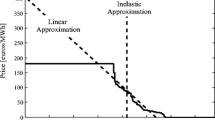Abstract
Consider a distribution system with one supplier and two retailers. When a stockout occurs at one retailer customers may go to the other retailer. We study a single period model in which the supplier may have infinite or finite capacity. In the latter case, if the total quantity ordered (claimed) by the retailers exceeds the supplier’s capacity, an allocation policy is involved to assign the limited capacity to the retailers. We analyze the inventory control decisions for the retailers using a game theoretical approach. The necessary and sufficient conditions are derived for the existence of a unique Nash equilibrium. A computational procedure is also proposed to calculate the Nash equilibrium. In case the Nash equilibrium does not exist, we use the concept of Stackelberg game to develop optimal strategies for both the leader and the follower.
Similar content being viewed by others
References
Anupindi, R. and Y. Bassok. (1999). “Centralization of Stocks: Retailers vs. Manufacturer.” Management Science 45, 178–191.
Cachon, G.P. and M.A. Lariviere. (1999). “An Equilibrium Analysis of Linear, Proportional and Uniform Allocation of Scarce Capacity.” IIE Transactions 31, 835–849.
Drezner, Z., H. Gurnani, and B.E. Pasternack. (1995). “An EOQ Model with Substitutions between Products.” Journal of Operational Researcl Society 46, 887–841.
Lippman, S.A. and K.F. McCardle. (1994). “The Competitive Newsboy.” Operations Research 45(1), 55–65.
Mahajan, S. and G. Van Ryzin. (2001). “Inventory Competition under Dynamic Consumer Choice.” Operations Research 49(5), 646–657.
McGillivray, A.R. and E.A. Silver. (1978). “Some Concepts for Inventory Control under Substitutable Demand.” INFOR 16, 47–63.
Mesterton-Gibbons, M. (2000). An Introduction to Game-theoretic Modelling, American Mathematical Society, Rhode Island.
Moulin, H. (1986). Game Theory for the Social Sciences, Second and Revised Edition, New York: New York University Press.
Netessine, N. and N. Rudi. (2002). “Centralized and Competitive Inventory Models with Demand Substitution.” forthcoming in Operations Research.
Nikaido, H. and K. Isora. (1955). “Notes on Noncooperative Convex Games.” Pacific Journal of Mathematics 5, 807–815.
Pasternack, B.A. and Z. Drezner. (1991). “Optimal Inventory Policies for Substitutable Commodities with Stochastic Demand.” Naval Research Logistics 38, 221–240.
Parlar, M. (1988). “Game Theoretic Analysis of the Substitutable Product Inventory Problem with Random Demands.” Naval Research Logistics 35, 397–409.
Author information
Authors and Affiliations
Corresponding author
Additional information
The work was partially supported by the National Textile Center of the US Department of Commerce under Grant No. I01-S01. The second author is supported in part by NSF under DMI-0196084 and DMI-0200306.
Rights and permissions
About this article
Cite this article
Dai, Y., Chao, X., Fang, SC. et al. Game Theoretic Analysis of a Distribution System with Customer Market Search. Ann Oper Res 135, 223–228 (2005). https://doi.org/10.1007/s10479-005-6243-7
Issue Date:
DOI: https://doi.org/10.1007/s10479-005-6243-7




